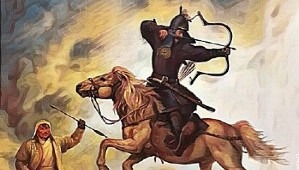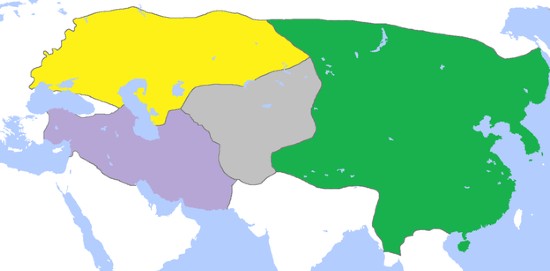MedievalReporter.com
Covering history's most marvelous millennium
Join our newsletter!

Covering history's most marvelous millennium
Covering history's most marvelous millennium
The Mongols were a steppe people that conquered large parts of the medieval world to form the largest land empire in world history. They did this mainly on horseback. This allowed them to cover distances no other army could compete with. Their often brutal conquests ushered in an era of stability and prosperity. They revitalized the Silk Road trade, after which their rule became known as the Pax Mongolica.
This is a short intro from our Medieval Guidebook. Dive deeper into the subject by reading our articles about it.

Genghis Khan was born as Temüjin in the middle of the High Middle Ages, in 1158 CE. He united the different Mongol tribes into a confederation and forged them into the Mongol Empire. Temüjin became its first Khagan, meaning ‘Great Khan’ – a rank in Turkic and Mongolic culture comparable to that of an emperor in Western Eurasia.
To underline his ambitions, he also took the name Genghis – meaning ‘universal’. Unsurprisingly then, under Genghis Khan, multiple armies soon fanned out in all directions. Mongol soldiers conquered Korea and Imperial China, destroyed Persia and the Islamic Caliphate, and invaded present-day Russia, Ukraine, Belarus, Romania, Poland, Hungary, Croatia, Austria, and Germany.
Genghis Khan perhaps is the greatest butcher in world history. Though reliable statistics remain elusive, his brutal campaigns may have been responsible for the deaths of tens of millions of people. On the more romantic side, he rescued his first wife after she had been kidnapped by a rival clan. But – befitting of a medieval steppe emperor – later in life, Genghis supposedly took over 500 other wives.
The Mongols were able to conquer so much land because of favorable weather conditions and their military organization. For starters, they fought mostly on horseback. Mongol warriors possessed two to four horses, so they could rotate to a fresh horse whenever one got tired.

A common Mongol unit was comprised of 60% horse archers and 40% lancers. This put enemies into a so-called double bind. The threat of the lancers forced enemy soldiers to draw up in ranks, but that made them sitting ducks for the horse archers. The constant barrage of arrows enticed enemy units to scatter, but that made them vulnerable to charges by Mongol lancers.
The Mongols were also very proficient in psychological warfare. During sieges, they did not refrain from slinging rotten carcasses over the city walls to infect the defenders. And when the Khan’s armies captured a city, they usually razed it to the ground.
This dissuaded other cities from putting up resistance, allowing the Mongol offensive to maintain its speed and momentum.
– advertisement –
– article continues below –
The Mongol Empire was treated as the Khan’s personal inheritance. This meant that when he died, the Mongol leaders had to return to the capital and elect a new one. The other sons usually received a “piece of the pie” in return for their support in the election.
Over time, the empire broke apart into these pieces. Separate khanates or khaganates – states ruled by a khan or khagan – came into being. They soon became formally independent.
Mongol military tactics also meant they couldn’t leave the steppe in force. The vast host of horses needed daily fodder and water. Arid or forested areas were therefore quite difficult for the Mongol army to penetrate.
The Mongols didn’t just scatter to the wind, though. In most areas they conquered, Mongol rulers dominated for centuries. For example, they created:

Not quite Genghis Khan’s idea of “one Khagan to rule them all”, but the Mongol influence on world history is large and unmistakable. To name but one such effect, the continent-spanning realm allowed one Marco Polo to travel relatively unscathed all the way from Venice, Italy, to the Far East.
Disclosure: we work hard to provide you with exclusive medieval reports and guides. To make the Middle Ages accessible to everybody, we’d like this information to remain FREE. Therefore, some of the links below are affiliate links, meaning – at no additional cost to you – we will earn a small compensation if you click through.
Grab a short intro on another civilization from our Medieval Guidebook.